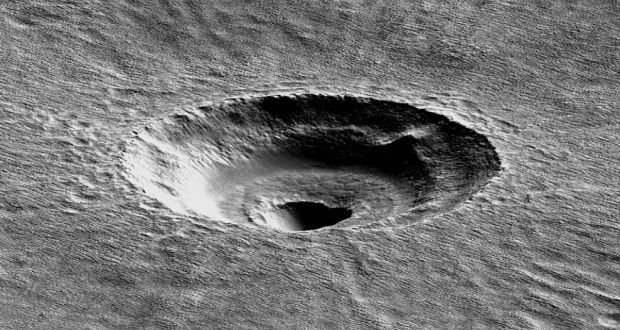A giant slab of ice as big as California and Texas combined lurks just beneath the surface of Mars between its equator and north pole, researchers say.
This ice may be the result of snowfall tens of millions of years ago on Mars, scientists added.
The discovery “could help us understand if locations on Mars were once habitable,” lead author Ali Bramson told the website on Thursday.
Experts already knew about the vast amounts of ice beneath the planet’s surface at high latitudes around the poles, but they recently started discovering water ice hidden in the middle and lower latitudes. Life and liquid water go hand-in-hand on Earth, so scientists believe Mars may have harbored life when it was wet, and living organisms may be hidden in underground aquifers.
Bramson, a planetary scientist at the LPL, and her colleagues, looked at an unusual crater in the Arcadia Planitia region of Mars, located in the mid-latitudes around the same region as the US-Canadian border on Earth. The crater is terraced, they explained, and between 1,075 and 1,410 feet (328 to 430 meters) wide.
How did the ice manage to survive all this time?
The terraced crater is somewhat unusual for Mars, the UA team said in a statement, as most craters are bowl-shaped. Using data from the NASA Mars Reconnaissance Orbiter (MRO) High Resolution Imaging Science Experiment (HiRISE) camera, they set out to learn why this crater had such an odd shape, creating 3D models of the surface to measure the depth of the terraces.
Bramson’s team then used the MRO’s Shallow Radar (SHARAD) instrument to fire radar pulses at Mars, which allowed them to measure how long it took for those signals to penetrate the layers of the surface and rebound to the orbiter. They combined both sets of data to determine the speed of the radar waves, which helped them determine that the layers were made of water ice.
The researchers also said they found an enormous hunk of ice located just below the regolith of the Red Planet. This icy slab is approximately 130 feet thick, Bramson and her colleagues said in research published Wednesday in the journal Geophysical Research Letters.
“Knowing where the ice is and how thick it is can tell you about Mars’ past climates” said associate professor and study co-author Shane Byrne in a statement. “The fact that the ice is so thick and widespread leads us to think it came into place during one of Mars’ past climates when it snowed a bunch, ice accumulated, was buried, and then preserved.”
“There have been a lot of climate changes between now and the tens of millions of years ago when we suspect the ice was put there. But it shouldn’t be stable today, and other past climates of ice instability in this region mean the ice should’ve sublimated away into the dry Martian atmosphere by now. So, that’s what we need to investigate,” he added. “What kept the ice around all this time? There’s no climate model that we have now that explains this.”
Agencies/Canadajournal
 Canada Journal – News of the World Articles and videos to bring you the biggest Canadian news stories from across the country every day
Canada Journal – News of the World Articles and videos to bring you the biggest Canadian news stories from across the country every day



